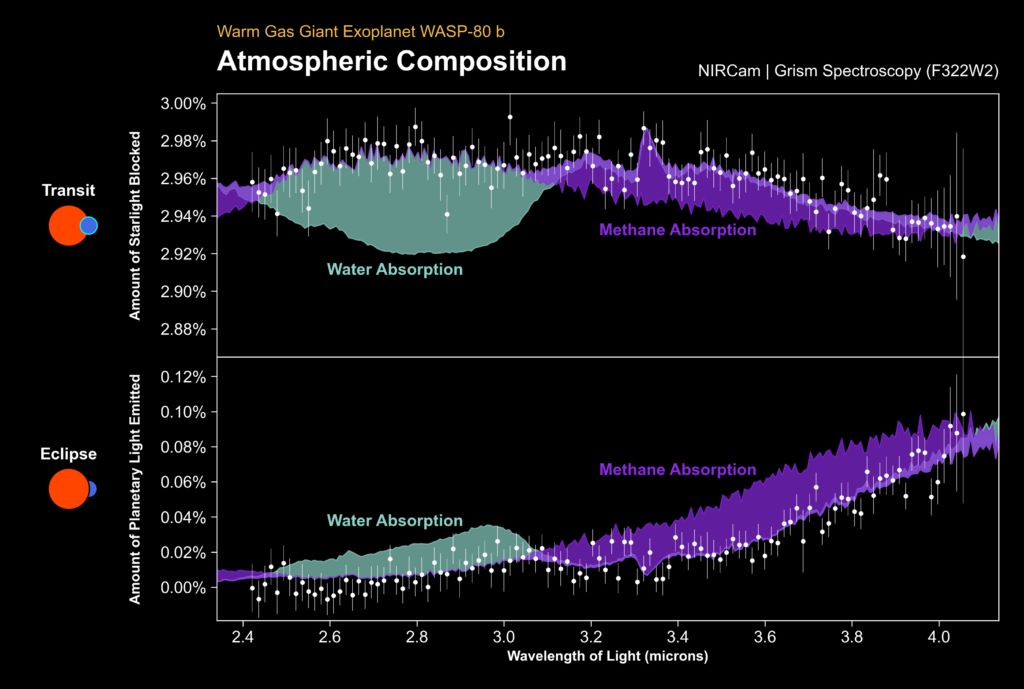Methane has been detected in the atmospheres of Jupiter, Saturn, Uranus and Neptune in our solar system. However, its presence in extraterrestrial atmospheres has remained elusive.
NASA’s James Webb Space Telescope observed the exoplanet WASP-80 b passing in front of and behind its host star. The telescope detected methane gas and water vapor in the planet’s atmosphere.
Dubbed 'Hot Jupiter’, exoplanet WASP-80 b has a temperature of about 825 Kelvin (about 1,025 degrees Fahrenheit). Located 163 light-years from Earth in the constellation Aquila, this exoplanet orbits its red dwarf star every three days.
Because of its close proximity to its star and its distance from us, the planet cannot be seen directly, even with the most advanced telescopes like Webb’s.
So, how did scientists identify the planet?
Scientists studied the combined light of the star and planet using transit and eclipse patterns. As the planet moved in front of its star, the transit system helped them track the system. The starlight they saw was a bit dim.
It’s like the light dimming when someone walks in front of the lamp. Around the planet’s day/night boundary, a thin ring of atmosphere is illuminated by the star during this period. The atmosphere appears thicker and blocks more starlight at certain wavelengths where its molecules absorb light, resulting in a deeper dimness than at other wavelengths where the atmosphere appears transparent.
The technique helps scientists understand the composition of the planet’s atmosphere by detecting the hues of light that are blocked.
On the other hand, using the eclipse method, the scientists observed the planet passing behind its star from their perspective, causing another slight dip in the total light they received. Thermal radiation is a type of light emitted by all materials; The amount and hue of light emitted depends on how hot the material is.
The planet’s hottest daylight faces us before and after the eclipse, so scientists can measure the infrared light the planet emits by observing the dip in light during the eclipse.
Absorption by molecules in the planet’s atmosphere is usually manifested as a decrease in the planet’s light emission at specific wavelengths in the ecliptic spectrum. Additionally, the depth of an ecliptic is significantly less than the depth of a transit because Earth is much smaller and more relaxed than its host star.

These initial observations must be converted into a spectrum.
The scientists noted, „There are many different tools for converting raw observations into useful spectra, so we used two different approaches to make sure our findings were robust to different assumptions.”
„Next, we interpreted these spectra using two types of models to simulate what a planet’s atmosphere might look like under such extreme conditions. The first type of model is completely flexible, trying to find the combination of millions of methane and water abundances and temperatures that best matches our data.
„The second type, called 'self-consistent models,’ examines millions of combinations, but uses our current knowledge of physics and chemistry to determine the amount of methane and water to expect. Both types of models arrive at the same conclusion: a definitive methane detection.”
The scientists next validated the findings with robust statistical methods to estimate the probability of finding them to be random noise.
They detected methane at 6.1-sigma in both eclipse and transit spectra, exceeding the 5-sigma „gold standard.” The scientists increased their confidence in both detections by placing the odds of a false detection at 1 in 942 million with each observation.
Scientists now hope to study the planet’s chemical composition to reveal the planet’s birth, growth and evolution.
Scientists Mentioned, „For example, by measuring the amount of methane and water in a planet, we can infer the ratio of carbon atoms to oxygen atoms. This ratio is expected to change depending on where and when planets form in their system. Therefore, examining this carbon-to-oxygen ratio, the planet gradually It can indicate whether it formed near or far away from its star before moving inward.
Journal Note:
- Bell, DJ, Wellbanks, L., Slavin, E. and many others. Methane throughout the atmosphere of the hot exoplanet WASP-80b. Nature 623, 709–712 (2023). DOI: 10.1038/s41586-023-06687-0

„Oddany rozwiązywacz problemów. Przyjazny hipsterom praktykant bekonu. Miłośnik kawy. Nieuleczalny introwertyk. Student.
